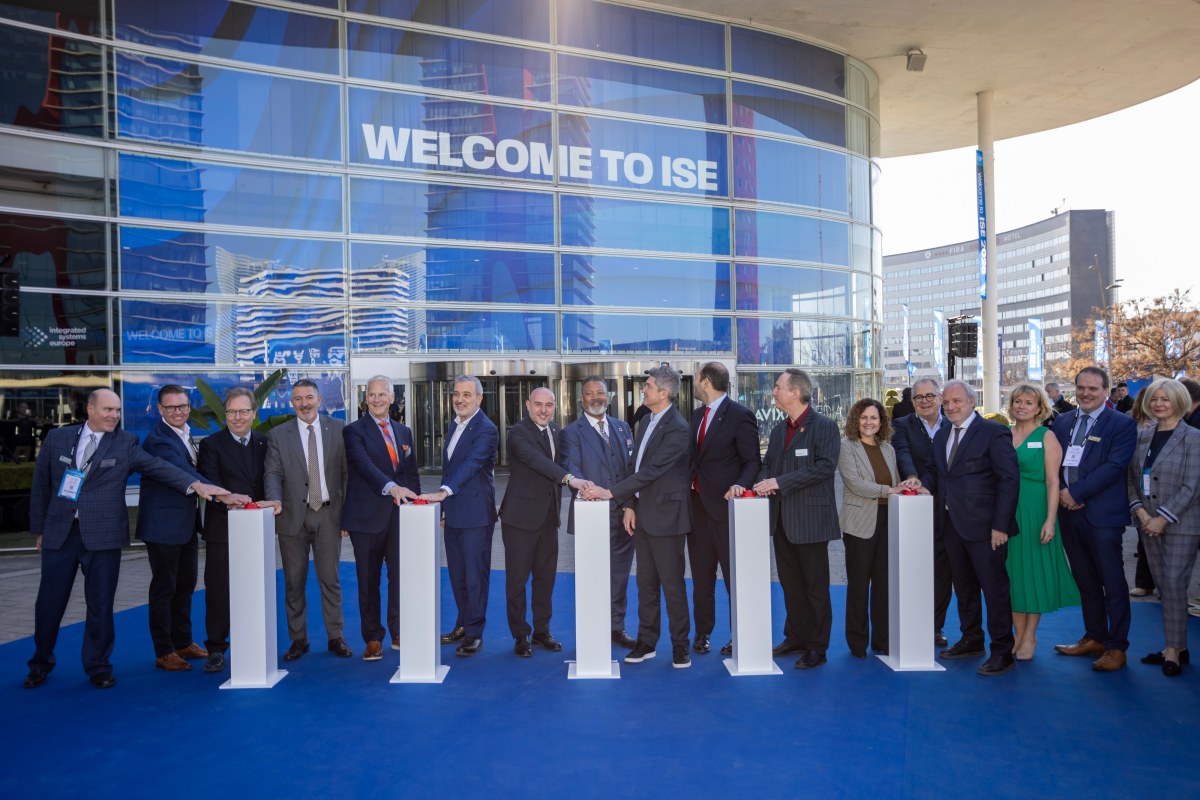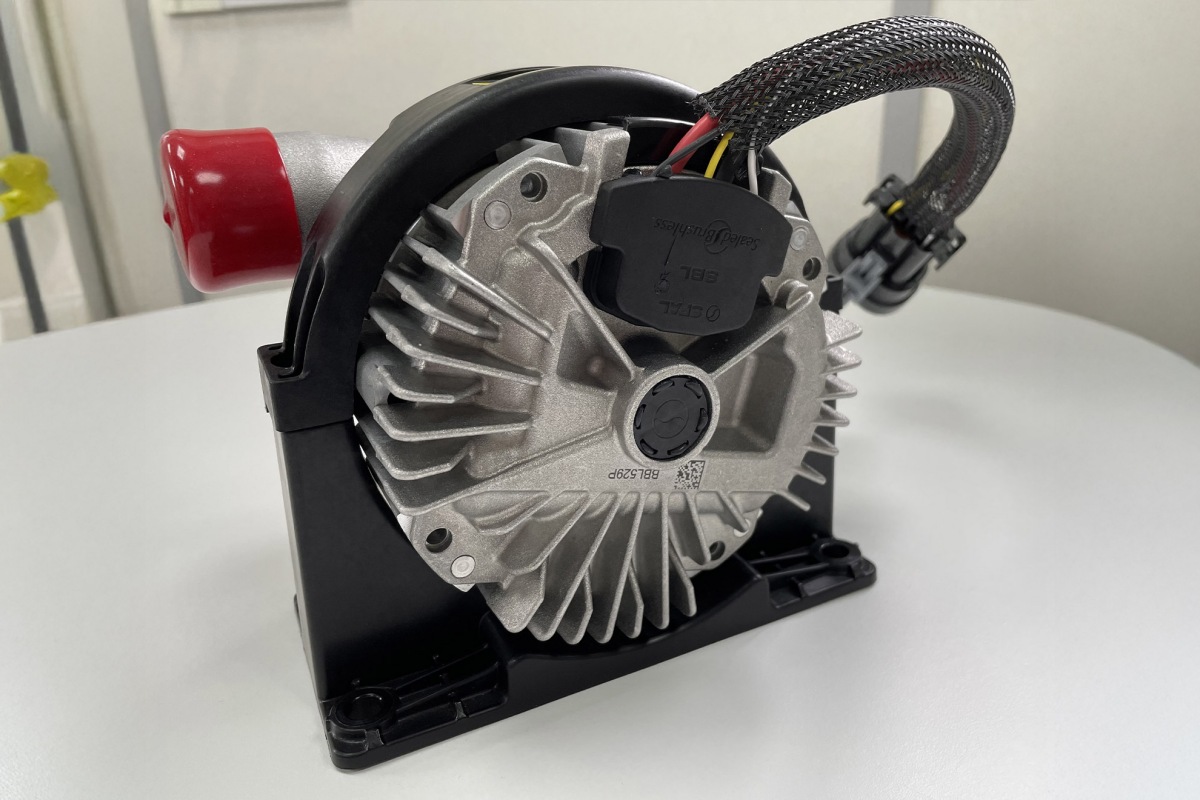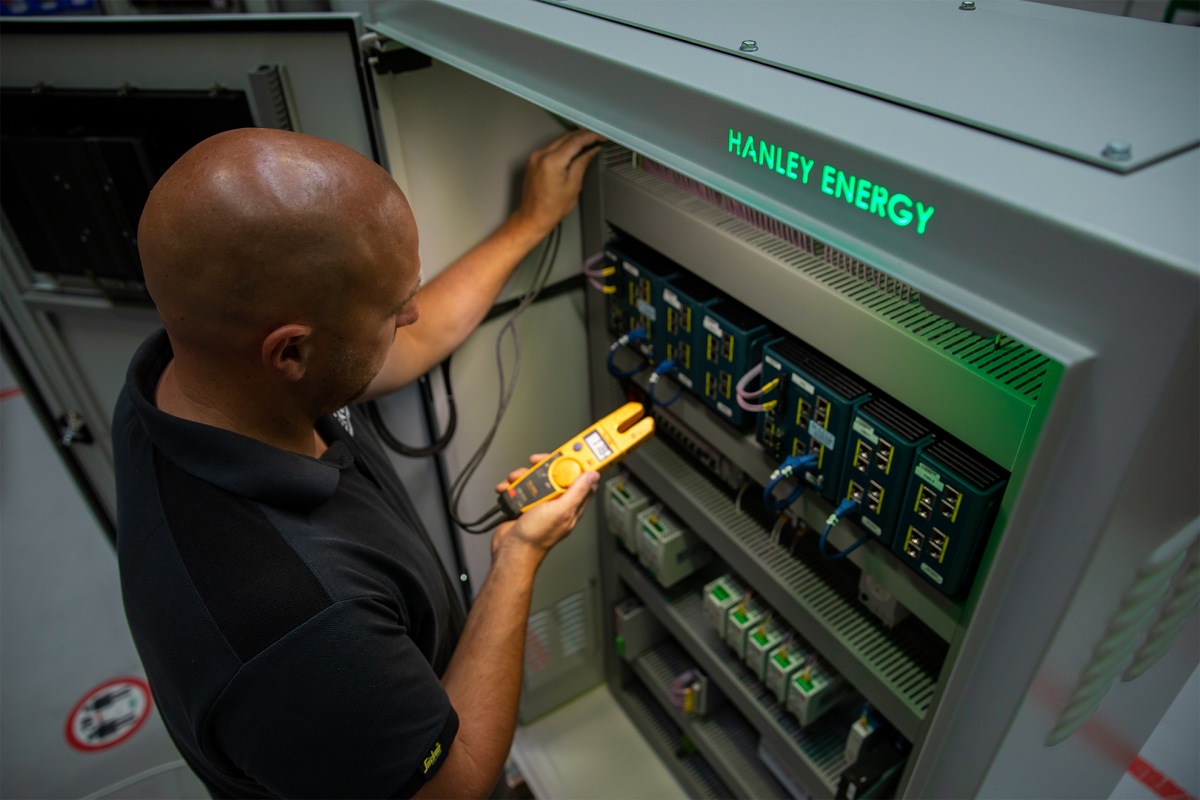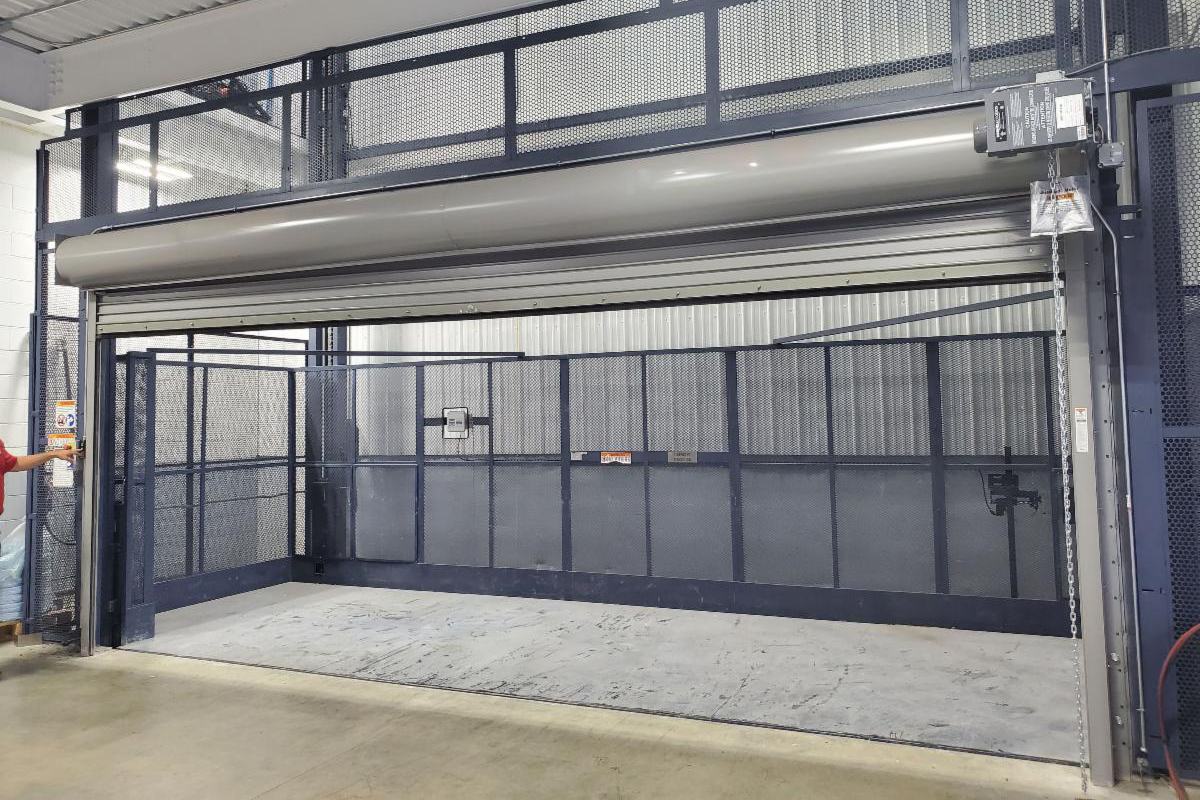9 January 2026
Southco develops blind-mate mechanism for liquid cooling
Southco develops blind-mate mechanism for liquid cooling
9 January 2026
Duos Edge AI deploys edge DC in Abilene, Texas
Duos Edge AI deploys edge DC in Abilene, Texas
9 January 2026
LiquidStack secures 300MW CDU order from major US operator
LiquidStack secures 300MW CDU order from major US operator
8 January 2026
Rethinking cooling, power, and design for AI
Rethinking cooling, power, and design for AI
8 January 2026
BCS Consultancy appoints new COO
BCS Consultancy appoints new COO
Latest News
Cyber Security Insights for Resilient Digital Defence
Data Centre Security: Protecting Infrastructure from Physical and Cyber Threats
Events
ISE 2026 returns to Barcelona
Integrated Systems Europe (ISE) 2026 returns to Fira de Barcelona, Gran Via from 3–6 February, inviting attendees to ‘Push Beyond’ the boundaries of cyber security and intelligence. The organisers state that this event is "where visionaries, creators, and innovators unite to shape the future, foster collaboration, and spark new ideas."
As AV systems become more integrated within enterprise, public sector, and venue settings, they are increasingly subject to the same security risks as conventional IT infrastructures. Whether deployed in control rooms, conferencing platforms, digital signage, smart buildings, or event venues, AV solutions have become prominent targets for threats such as ransomware, data breaches, social engineering, and denial-of-service attacks.
ISE 2026 aims to push beyond to dive deeper into this defining megatrend, the importance of collaboration and innovation, and preparing AV professionals for safeguarding the future from emerging digital threats.
CyberSecurity Summit
On Thursday, 5 February, 09:00–12:00 in CC5.1, ISE 2026 will host the brand-new CyberSecurity Summit, a gathering for AV professionals and business leaders determined to strengthen their organisation’s defences.
Recognising cyber security as a business-critical priority, the Summit will examine its pivotal role in securing public tenders, ensuring regulatory compliance, and maintaining client trust.
Expert speakers will address urgent real-world challenges, guide delegates in pinpointing the most pressing risks, and outline practical, actionable strategies.
During the summit, AV professionals will learn about safeguarding critical systems, navigate evolving regulations like NIS2 and ISO 27001, and transform cyber security from a vulnerability into a strategic advantage.
Attendees should leave equipped with a clear, sector-relevant roadmap to enhance their organisations' digital resilience in an increasingly connected world.
Summit Chair Pere Ferrer i Sastre, former Director General of the Catalan Police (Mossos d’Esquadra), has extensive experience in public security, digital transformation, regulatory frameworks, and critical infrastructure management. He will facilitate discussions addressing emerging digital threats to the AV and systems integration sectors from years of experience in the field.
Cybersecurity megatrends
This feeds into one of ISE’s defining megatrends for 2026: cyber security. These are environments where safeguarding critical infrastructure and public services against cyber threats has become paramount.
At ISE 2026, you’ll discover how the cyber security ecosystem is pushing beyond boundaries to deliver intelligent, resilient, and secure systems that are equipped to protect public sector operations and ensure ongoing wellbeing amidst evolving digital threats.
Other megatrends include: AI, robotics, smart spaces, sustainability, and tradescape.
Strategies, innovation, and collaboration at ISE Hackathon
Putting cyber security prevention into action, the ISE Hackathon brings together a dynamic community of highly skilled participants, representing top international universities.
For 48 hours, the student participants will engage in rapid networking, collaboration, brainstorming, and innovation engineering to solve a business challenge, before pitching their ideas to the judging panel.
This year, the event will once again offer three separate tracks: cyber security, sustainability, and innovation.
The Hackathon is designed to serve as a catalyst for innovation, challenging participants to address critical security challenges through collaborative problem-solving.
Connect, collaborate, and revolutionise
Sol Rashidi, Chief AI Officer for enterprises, will headline ISE on Wednesday, 5 February 2026. Her keynote, ‘The AI Reality Check: What It Takes to Scale and the Future of Leadership’, will aim to expose the realities of AI beyond the hype, offering practical frameworks and highlighting the importance of AI governance and cyber security for successful scaling.
The organisers say ISE 2026 is "more than just an exhibition; it’s a platform for networking, learning, and discovering new ways to drive value in your organisation."
With opportunities to meet leading brands, share knowledge with peers, and explore emerging trends in cyber security and AI, those running the event hope every attendee will leave better equipped for the challenges ahead.
Why attend ISE 2026?
Whether you’re focused on enhancing communication within your organisation or delivering unforgettable live experiences, ISE 2026 is the event that brings it all together.
Don’t miss your chance to be at the forefront of industry transformation. Click here to head to the website and register for free with the code ‘dcnnews’ to secure your place.
Joe Peck - 8 January 2026
Data Centre Business News and Industry Trends
Data Centre Infrastructure News & Trends
Innovations in Data Center Power and Cooling Solutions
Insights into Data Centre Investment & Market Growth
Schneider Electric names new VP
Global energy technology company Schneider Electric has appointed Matthew Baynes as Vice President of its Secure Power and Data Centre division for the UK and Ireland.
Matthew takes up the role as both countries see rapid growth in digital infrastructure investment, driven by rising demand from artificial intelligence workloads, accelerated data centre construction, and government-backed initiatives.
Experience across data centre leadership
Matthew has worked in Schneider Electric’s data centre business for nearly 20 years. His most recent position was Global Vice President for Strategic Partners and Cloud and Service Providers, where he led a global team supporting colocation, cloud, and hyperscale customers.
Earlier roles included Global Colocation Segment Director, where he launched the company’s first multi-country account programme, now established as a core element of its global approach.
Matthew has also held senior leadership positions in the UK and Ireland since Schneider Electric acquired APC in 2007 and worked for several years in the Netherlands supporting European operations.
Alongside his corporate responsibilities, Matthew has contributed to industry bodies including techUK and the European Data Centre Association, supporting policy engagement and sustainability initiatives.
Commenting on his appointment, Matthew says, “The UK is one of Europe’s most important and vibrant digital infrastructure hubs and, with AI accelerating demand, the next few years present a major opportunity to strengthen its global leadership position.
"At the same time, Ireland continues to play a critical role in the region’s digital ecosystem, with its data centre market serving key customers globally.
“Data centres are engines for jobs and competitiveness, supporting growth that benefits the digital economy, local communities, and empowering innovation. This is a pivotal moment to shape their role in the UK and Ireland’s digital future, and I’m delighted to accept this new role at such a crucial time.”
Pablo Ruiz-Escribano, Senior Vice President for the Secure Power and Data Centre division in Europe, adds, “Matthew’s deep experience in global strategy and both local and regional execution makes him uniquely positioned to lead our Secure Power business in the UK and Ireland during this critical period of growth.”
Matthew assumes the role with immediate effect.
For more from Schneider Electric, click here.
Joe Peck - 7 January 2026
Commercial Real Estate: Property Developments, Trends & Infrastructure
Data Centre Build News & Insights
Data Centre Business News and Industry Trends
Data Centre Projects: Infrastructure Builds, Innovations & Updates
Nostrum, JLL partner for 800MW development in Spain
Nostrum Data Centers, a developer of sustainable data centre infrastructure across Spain and Europe, has engaged JLL, a global commercial real estate and investment management company, to advance its AI-ready platform in Spain.
Leveraging JLL’s global data centre experience, Nostrum says it is aiming to strengthen its customer engagement strategy and advance Spain’s emergence as a next-generation connectivity hub.
In December 2025, Nostrum announced its data centre assets will be available in 2027, with power and land secured across all sites. The company is developing 500 MW of sustainable IT capacity across Spain, with an additional 300 MW planned for expansion.
The company’s six data centre developments are strategically located throughout Spain to leverage existing connectivity and power infrastructure. Each facility is in alignment with the United Nations Sustainable Development Goals (SDGs), offering a PUE of 1.1 and a WUE of zero, eliminating water usage for cooling.
Sustainable development in Spain
Gabriel Nebreda, Chief Executive Officer at Nostrum Group, comments, “Nostrum Data Centers has a long-term vision for balancing innovation and sustainability.
"We offer our customers speed-to-market and scalability throughout our various locations in Spain, all while leading a green revolution to ensure development is done the right way as we position Spain as the next connectivity hub.
“We are confident that our engagement with JLL will be able to help us bolster our efforts and achieve our long-term vision.”
Jason Bell, JLL Senior Vice President of Data Center and Technology Services in North America, adds, “Spain has a unique market position with its access to robust power infrastructure; its proximity to Points of Presence (PoPs), internet exchanges, subsea connectivity; and being one of the lowest total cost of ownership (TCO) markets.
“JLL is excited to be working with Nostrum Data Centers, providing our expertise and guidance to support their quest to be a leading data centre platform in Spain, as well as position Spain as the next connectivity hub in Europe and beyond.”
For more from Nostrum Data Centers, click here.
Joe Peck - 7 January 2026
Data Centre Infrastructure News & Trends
Innovations in Data Center Power and Cooling Solutions
Liquid Cooling Technologies Driving Data Centre Efficiency
Products
SPAL targets data centre cooling needs
SPAL Automotive, an Italian manufacturer of electric cooling fans and blowers, traditionally for automotive and industrial applications, is preparing to showcase its cooling technology at Data Centre World in London in March 2026, with a particular focus on brushless drive water pumps used in data centre thermal management.
The pumps are designed for stationary applications where cooling demand is continuous and high. They feature software control compatibility - including CAN, PWM, and LIN - supporting precise regulation of coolant flow and temperature.
The company says the pumps consume less power than mechanically driven units and use IP6K9K-rated brushless systems intended to mitigate issues such as overload, reverse polarity, and overvoltage.
The role of cooling components in data centres
Alongside its pumps, SPAL will display its wider cooling portfolio, which includes fans and blowers designed for controlled airflow and heat dissipation.
The company plans to highlight the use of matched replacement components, particularly for systems that rely on coordinated assemblies of fans, pumps, and related controls.
James Bowett, General Manager at SPAL UK, says, “In a world where costs are constantly under pressure, it’s false economy to opt for cheaper parts as this will not only affect the performance of the component itself, but the entire suite of parts within a system.
"The only way to ensure effective, reliable, long-life operation is to replicate the set up installed at the point of manufacture. That means choosing the best calibre parts throughout.”
SPAL states that its products are supplied with a four-year manufacturer’s warranty and are used to help maintain stable conditions for sensitive electronics.
The company highlights that the growth of data centres linked to AI and cloud services is increasing demand for equipment designed specifically for energy efficiency, water use, and controlled cooling.
SPAL will exhibit at Data Centre World on Stand F15, held at ExCeL London on 4–5 March 2026.
Joe Peck - 7 January 2026
Data Centre Build News & Insights
Data Centre Business News and Industry Trends
Data Centre Projects: Infrastructure Builds, Innovations & Updates
Insights into Data Centre Investment & Market Growth
Global data centre build-out projected to require $3tn
The global data centre sector is poised for continued unprecedented expansion, with capacity expected to nearly double from 103 GW to 200 GW by 2030, according to real estate and investment management company JLL’s newly released 2026 Global Data Center Outlook report.
Artificial intelligence is rapidly reshaping the data centre landscape, and JLL anticipates AI workloads will represent half of all data centre capacity by 2030. Despite rapid growth, the fundamentals for the sector remain healthy and property metrics do not point to a bubble.
The explosive growth will require up to $3 trillion (£2.2 trillion) in total investment over the next five years, including $1.2 trillion (£887 billion) in real estate asset value creation and approximately $870 billion (£643 billion) in new debt financing, marking an infrastructure investment supercycle.
“We’re witnessing the most significant transformation in data centre infrastructure since the original cloud migration,” notes Matt Landek, Global Division President, Data Centers and Critical Environments at JLL. “The sheer scale of demand is extraordinary. Hyperscalers are allocating $1 trillion (£739 billion) for data centre spend between 2024 and 2026 alone, while supply constraints and four-year grid connection delays are creating a perfect storm that’s fundamentally reshaping how we approach development, energy sourcing, and market strategy.”
AI drives transformation
AI workloads could represent 50% of all data centre capacity by 2030, compared to approximately 25% in 2025. JLL anticipates a critical inflection point in 2027 when AI inference workloads will overtake training as the dominant requirement.
“We’re witnessing the emergence of an entirely new infrastructure paradigm where AI training facilities demand 10x the power density and command 60% lease rate premiums over traditional data centres,” explains Andrew Batson, Global Head of Data Center Research at JLL. “Beyond the economics, AI has become a matter of national strategic importance, driving countries to develop domestic capabilities through sovereign infrastructure investments that represent an $8 billion (£6 billion) CapEx opportunity by 2030.”
AI chips are projected to grow their total revenue share from 20% to 50% of the semiconductor market by 2030, with custom silicon expected to capture 15% market share as hyperscalers develop their own processors. The future could include emerging technologies like neuromorphic computing for ultra-efficient inference tasks that could reduce infrastructure demands and enable data centres to be more power-efficient.
Regional growth patterns
The Americas will maintain its position as the largest data centre region, representing about 50% of global capacity and achieving the fastest growth rate through 2030. The Asia-Pacific (APAC) region is projected to expand from 32 GW to 57 GW, while Europe, the Middle East, and Africa (EMEA) will add 13 GW of new supply.
Each region faces distinct market dynamics that will shape development strategies. In APAC, colocation is leading growth, while on-premise capacity is projected to decline 6% as enterprises continue cloud migration. EMEA’s growth forecast is fuelled by strong demand from hyperscalers, with growth concentrated in established European hubs like London, Frankfurt, and Paris, alongside emerging Middle Eastern markets pursuing digital transformation strategies. The US continues to drive most activity in the Americas, accounting for about 90% of regional capacity.
Market fundamentals remain strong
Property metrics do not indicate a bubble, as JLL’s analysis indicates the sector maintains healthy fundamentals with 97% global occupancy and 77% of the construction pipeline pre-committed to tenants.
Global lease rates are forecast to increase at a 5% CAGR through 2030, with the Americas leading at 7% annual growth due to severe supply constraints.
Despite developers preordering materials up to 24 months in advance, more than half of projects in 2025 experienced construction delays of three months or more. The average equipment lead time globally is now 33 weeks, a 50% increase from pre-2020 levels. The industry is responding through modular construction solutions, with annual sales of modular systems and micro data centres projected to reach $48 billion (£35 billion) by 2030.
“The increase in equipment lead times is affecting APAC just as it is globally, but strong pre-commitment levels demonstrate continued confidence in the market,” says Glen Duncan, JLL Data Center Research Director, Asia Pacific.
Energy and sustainability challenges
Energy sourcing remains a critical challenge, with average grid connection lead times exceeding four years in primary markets. Due to utility interconnection delays and mounting pressure from rising grid electricity costs, some operators are moving to directly fund their own energy generation, and several markets have implemented de facto 'bring your own power' mandates, including Dublin and Texas.
Data centres are also adopting diverse regional energy strategies to address grid constraints. Natural gas is projected to play a major role in alleviating grid constraints in the US, both for temporary bridge power and increasingly for permanent on-site power generation. The four primary hyperscalers are already fully matching their US data centre portfolios with renewable energy. In EMEA, projects combining renewables and private wire transmission can reduce the cost of power for tenants by 40% compared to the grid.
Battery energy storage systems (BESS) are gaining momentum, enabling cost-effective handling of short-duration outages and positioning the technology as a dynamic grid asset to speed up interconnection timelines. Additionally, solar-plus-storage will become a key component of global data centre energy strategies by 2030, with renewable energy costs projected to outcompete fossil fuels across all major regions.
“As regulatory and stakeholder expectations around renewable energy sourcing increase globally, data centre operators will face heightened scrutiny over their energy procurement,” suggests Martin Jensen, EMEA Division President, Data Centers at JLL. “While renewables like solar and wind remain the dominant focus of clean energy strategies, power sources such as nuclear are gaining attention for their ability to provide reliable electricity and help balance sustainability requirements with operational continuity; however, significant new nuclear capacity is unlikely to be widely deployed before the 2030s.”
Capital markets evolution
The sector is experiencing significant capital markets maturation, with core investment strategies now representing 24% of fundraising activity, up from less than 10% previously. More than $300 billion (£221 billion) in global M&A activity has occurred since 2020, though future investment is expected to shift towards recapitalisations and joint ventures as the market matures.
Global data centre core fund capital formation could top $50 billion (£37 billion) in 2026, with strategies targeting returns of 10% or more. ABS and CMBS securities are quickly becoming a solution for financing rapid sector expansion, with issuance volumes roughly doubling every year since 2020 and projected to reach $50 billion (£37 billion) in 2026.
For more from JLL, click here.
Joe Peck - 6 January 2026
Data Centre Business News and Industry Trends
Data Centre Infrastructure News & Trends
Innovations in Data Center Power and Cooling Solutions
Insights into Data Centre Investment & Market Growth
Jabil acquires Hanley Energy Group
Jabil, a US provider of electronics manufacturing and supply chain services, has completed the acquisition of Hanley Energy Group, a provider of energy management and critical power systems for the data centre infrastructure market.
The transaction was completed on 2 January 2026 and was valued at approximately $725 million (£536 million), with contingent consideration of up to $58 million (£42.8 million) linked to future revenue targets.
The acquisition was completed as an all-cash transaction. TM Capital acted as exclusive financial adviser to Hanley Energy Group, while UBS Investment Bank advised Jabil.
A focus on data centre power management
Jabil says the acquisition is intended to strengthen its capabilities in data centre power management, particularly as demand increases from artificial intelligence workloads.
Hanley Energy Group operates across 13 locations globally - with headquarters in Stamullen, Ireland, and in Ashburn, Virginia, USA - employing around 850 staff.
Founded in 2009, Hanley Energy Group works across the design, supply, installation, and commissioning of power and energy management systems, supporting infrastructure from the grid through to the data centre rack. The company also provides lifecycle services, including maintenance and operational support.
Matt Crowley, Executive Vice President of Global Business Units, Intelligent Infrastructure at Jabil, comments, “We're excited to welcome Hanley Energy Group and their extensive expertise in power systems and energy optimisation to the Jabil team.
"Their know-how and capabilities complement Jabil’s existing power management solutions for data centres and will help us deploy and service them down to the rack level.”
Ed Bailey, Senior Vice President and Chief Technology Officer, Intelligent Infrastructure at Jabil, adds, “Data centre power management will only become more critical as hyperscalers ramp the availability of their AI technologies.
"This acquisition of Hanley Energy Group, coupled with our growing thermal management capabilities, aligns well with Jabil’s strategy to deliver custom solutions for the world’s AI leaders across the data centre lifecycle.”
Clive Gilmore, CEO of Hanley Energy Group, notes, “Joining forces with Jabil will supercharge our ability to deliver end-to-end, scalable, and energy-efficient solutions for the world’s most demanding data centre environments.
"Our customers will benefit from the expanded reach of Jabil’s global manufacturing footprint and supply chain, access to broader capabilities across the data centre lifecycle, and opportunities for sustainable growth to meet the evolving needs of AI hyperscalers.”
Dennis Nordon, Managing Director at Hanley Energy Group, concludes, “This is more than an acquisition; it’s a catalyst for the future of data centre power management. By joining with Jabil, we are positioned to lead the charge in delivering intelligent, sustainable solutions that empower hyperscalers to unlock the full potential of AI.”
Joe Peck - 6 January 2026
Data Centre Business News and Industry Trends
Insights into Data Centre Investment & Market Growth
News
VIRTUS Data Centres names new CEO
VIRTUS Data Centres, a UK data centre owner-operator and part of ST Telemedia Global Data Centres (STT GDC), today announced the appointment of Adam Eaton as Chief Executive Officer, effective immediately.
Under Adam’s leadership, VIRTUS says it will continue to "expand [its] portfolio of high-efficiency, sustainable data centres, building on a decade of rapid growth across the UK and Europe."
The company adds that it "remains committed to [its] vision to deliver world-class, energy-efficient infrastructure that supports the growth of the digital economy."
Bruno Lopez, President and Group CEO at STT GDC and Chairman at VIRTUS Data Centres, comments, “We are delighted to welcome Adam to VIRTUS at an exciting time.
"His insight and proven ability to scale complex operations make him the ideal leader for the business as VIRTUS continues to grow its footprint and strengthen its position as one of Europe’s leading data centre operators.
"We look forward to this new chapter of leveraging Adam’s knowledge, expertise, and stakeholder management skills for further growth across the business.”
Adam says, “I first met the VIRTUS team over 15 years ago. Since then, I’ve watched the company evolve into one of Europe’s leading data centre operators.
"Helping VIRTUS scale and support its next phase of growth is an exciting opportunity. I’m privileged to build on the foundations laid by the existing team, embracing one of the most exciting leadership roles in the industry today.”
Decades of experience
Adam brings a combination of commercial and operational expertise to VIRTUS. With over 20 years of experience spanning the data centre, cloud, and managed services sectors, he brings a track record of strategic leadership, business transformation, and operational performance.
Most recently, Adam served as Executive Group Director for Europe at Global Switch, where he led the business across the FLAPM (Frankfurt, London, Amsterdam, Paris and Madrid) markets and drove transformation plans to strengthen the business’ performance and scale.
Adam steps into the CEO role previously held by Thomas Ee, Group Chief Operating Officer of STT GDC, in an interim capacity for the past nine months.
For more from VIRTUS, click here.
Joe Peck - 6 January 2026
Data Centre Architecture Insights & Best Practices
Data Centre Build News & Insights
Exploring Modern Data Centre Design
PFlow highlights VRC use in data centres
PFlow Industries, a US manufacturer of vertical reciprocating conveyor (VRC) technology, has highlighted the use of VRCs within data centre environments, focusing on its M Series and F Series systems.
VRCs are typically incorporated during the design phase of a facility to support vertical movement of equipment and materials.
PFlow states that, compared with conventional lifting approaches, VRCs can be integrated with automated material handling systems and used for intermittent or continuous operation, with routine maintenance requirements kept relatively low.
M Series and F Series applications
The PFlow M Series 2-Post Mechanical Material Lift is designed for higher-cycle environments where frequent vertical movement of equipment is required.
The company says the system can handle loads of up to 10,000lb (4,536kg) and operate across multiple floor levels. Standard travel speed is stated as 25 feet (7.62 metres) per minute, with higher speeds available depending on configuration.
The M Series is designed for use for transporting items such as servers, racks, and other technical equipment, with safety features intended to support controlled movement and equipment protection.
The PFlow F Series 4-Post Mechanical VRC is positioned for heavier loads and larger equipment. The standard lifting capacity is up to 50,000lb (22,680kg), with higher capacities available through customisation.
The design allows loading and unloading from all four sides and is intended to accommodate oversized infrastructure, including battery systems and large server assemblies.
PFlow says the F Series is engineered for high-cycle operation and flexible traffic patterns within facilities.
The company adds that its VRCs are designed as permanent infrastructure elements within buildings rather than standalone equipment. It states that all systems are engineered to meet ASME B20.1 conveyor requirements and are intended for continuous operation in environments where uptime is critical.
Dan Hext, National Sales Director at PFlow Industries, comments, “Every industry is under cost and compliance pressure. Our VRCs help facility operators achieve maximum throughput and efficiency while maintaining the highest levels of safety.”
Joe Peck - 5 January 2026
Cyber Security Insights for Resilient Digital Defence
Data Centre Security: Protecting Infrastructure from Physical and Cyber Threats
Security Risk Management for Data Centre Infrastructure
SIA launches data centre advisory board
The Security Industry Association (SIA), a trade association for global security solution providers, has launched a new Data Center Advisory Board to provide guidance on data centre security matters to its Board of Directors and to support SIA members with relevant resources.
The group will be chaired by Jim Black, Senior Director and Security Architect at Microsoft, who has been involved in the company’s cloud and data centre operations since 2011.
The establishment of the advisory board comes as global demand for data centre capacity continues to rise, driven by artificial intelligence, cloud services, and other digital technologies.
As facilities that host large volumes of sensitive information, data centres face increasing pressure to maintain robust and resilient security practices.
A focus on collaboration and guidance
According to SIA, the Data Center Advisory Board will contribute to the development of guidance and information related to security deployments, encourage collaboration between security providers and data centre security professionals, and engage with SIA’s government relations team on legislative and regulatory matters where relevant.
In his role at Microsoft, Jim is responsible for defining security technology strategy to protect assets and personnel across a global portfolio of more than 400 data centres.
He holds several professional certifications, including Certified Protection Professional and Physical Security Professional from ASIS International, as well as Certified Information Systems Security Professional from ISC².
Commenting on his appointment, he notes, “The data centre industry is experiencing unprecedented growth and heightened risks driven by emerging technologies and global operational challenges.
"I am honoured to serve as SIA’s inaugural Data Center Advisory Board Chair and look forward to working with this accomplished group of industry experts to advance and publish modern security standards that will strengthen cloud critical infrastructure protection worldwide.”
Don Erickson, CEO of SIA, says Jim’s experience makes him well suited to the role, commenting, “The Data Center Advisory Board is an important venture for SIA, and we are very pleased that it will be able to benefit from Jim’s experience and expertise in data centre security from its inception.
“Jim has for many years been an enthusiastic and generous supporter of SIA, contributing to multiple groups and projects that have advanced the industry’s professionalism and knowledge base. We are excited about what the advisory board will accomplish under his leadership.”
Joe Peck - 5 January 2026
Data Centre Build News & Insights
Data Centre Operations: Optimising Infrastructure for Performance and Reliability
Data Centre Projects: Infrastructure Builds, Innovations & Updates
Edge Computing in Modern Data Centre Operations
Duos Edge AI expands US edge data centres
Duos Technologies Group, through its subsidiary Duos Edge AI, a provider of edge data centre (EDC) systems, has expanded its EDC footprint in Texas and entered the Illinois market, serving the Greater Chicago area.
The company reports continued deployments across several Texas locations and that the Illinois site represents its first installation in the Midwest.
Duos Edge AI says further sites are planned as part of a broader geographic expansion.
Texas and Midwest deployments
In Texas, Duos Edge AI has added two edge data centres in Lubbock to support carrier neutral requirements. The company has also deployed sites supporting education, healthcare, and service providers in Amarillo, Victoria, Waco, Dumas, and Corpus Christi.
The Illinois deployment is located in the Greater Chicagoland area and is described as the first of multiple planned installations in the Midwest.
According to the company, the Lubbock sites are intended to address service provider demand, while the broader Texas portfolio supports a range of public and private sector use cases.
Duos Edge AI’s modular edge data centres include security controls aligned with SOC 2 Type II certification under AICPA standards. The company also references its patented modular data centre entryway design, which is intended to protect equipment in controlled environments.
Commenting on the expansion, Doug Recker, President of Duos and founder of Duos Edge AI, says, “Expanding within Texas and into the Illinois market is a meaningful milestone that reflects both execution discipline and rising demand for our Edge Data Center.
"We are building a scalable, repeatable deployment model that supports education, carriers, and enterprises with secure, low-latency infrastructure.
"These expansions align with our growth strategy and reinforce our confidence in continued momentum as we execute against our long-term guidance.”
Duos Edge AI states that it plans to expand into additional US states, focusing on carrier neutral facilities that support localised compute and edge infrastructure requirements in a range of markets.
For more from Duos Edge AI, click here.
Joe Peck - 2 January 2026

Head office & Accounts:
Suite 14, 6-8 Revenge Road, Lordswood
Kent ME5 8UD
T: +44 (0)1634 673163
F: +44 (0)1634 673173









